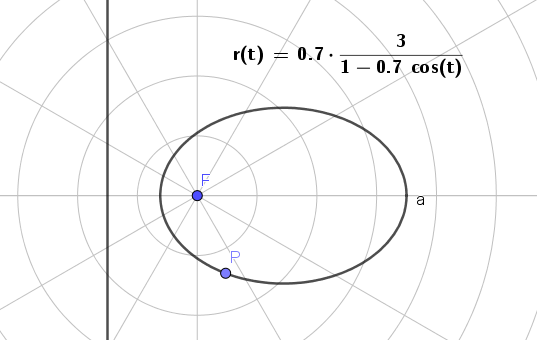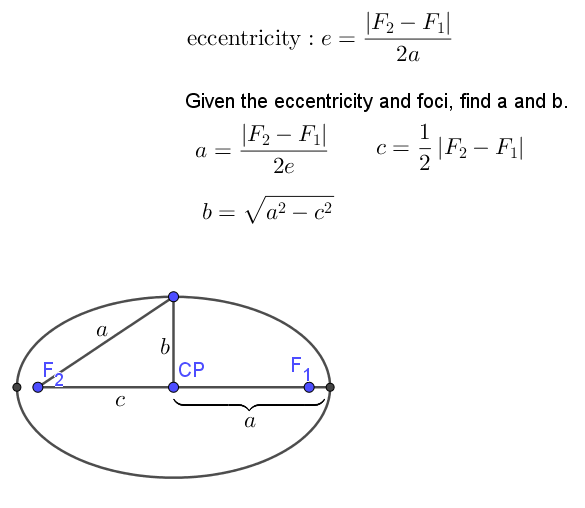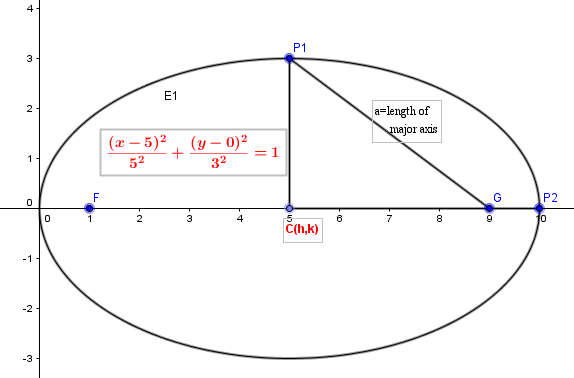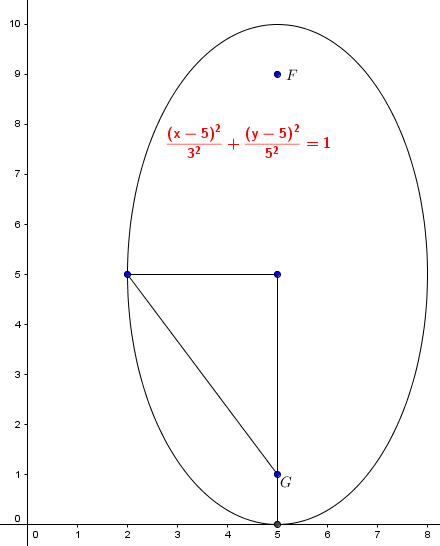Eccentricity
Definition: Eccentricity, $\mathbf{e}$, is defined as the distance between foci divided by the total length of the major axis. That is, $$\frac{\left\Vert F_{1}-F_{2}\right\Vert }{2a}=\mathbf{e}$$ For an ellipse eccentricity is always between $1$ and $0$. At zero, the ellipse becomes a circle. At $\mathbf{e}=1$, the ellipse becomes a parabola.
Additionally, eccentricity is defined as a constant ratio of two distances, the distance from some point, $P$, on the curve to a focus and the distance from that same point P to a directrix line. The directrix lines are symetrical off both ends of the major axis and are parallel to the minor axis. Their distance from the minor axis is $$\text{directrix distance to minor axis}=\frac{a^{2}}{c}=\frac{a}{e}$$ A focal point (only one) and a directrix line serve to define the ellipse. Let $|P-A|$ be the distance from point $P$ on the ellipse to a vertical directrix line. Point $A$ is on the directrix line and has the same $y\text{‑coordinate}$ as $P$ so that the line from $P$ to $A$ makes a right angle with the directrix. $$\mathrm{e}=\frac{\left\Vert P-Focus\right\Vert }{\Vert P-A\Vert}=\frac{c}{a} \tag{1} \label{1}$$ The ratios in $\eqref{1}$ are correct, but they do not imply that the distances are equal to the constants. Indeed the distances are not constant since both the Focus at the origin is fixed and the directrix is fixed, but $P$ moves everywhere on the ellipse.
We have already done two ellipse derivations, a Cartesian one and a Polar one, but in both cases, we used definition 1, which is that the sum of distance from the ellipse to both foci is constant. We can also derive the ellipse from definition 2, The ratio of distance to focus over distance to directrix is equal to $\mathbf{e}$. In the general case, for a rotated ellipse, it is possible but with a lot of algebra. Here we will do a very simple case just to show it can be done.

Put a focus, $F=(0,0)$. Pick a vertical directrix line, $x=-p$, picked such that the directrix will be outside and to the left of the ellipse. Let $P=(x,y)$ a point on the ellipse. Let $A$ be the point on the directrix that is the closest point to $P$. The coordinates of point $A=(-p,y)$. By the definition $$\frac{\left\Vert P-F\right\Vert }{\left\Vert P-A\right\Vert }=\mathbf{e}.$$ Now make substitutions for $P$, $F$, and $A$ and expand the equation. $$|P-F|=\sqrt{(x-0)^{2}+(y-0)^{2}}$$ $$|P-A|=\sqrt{(x--p)^{2}+(y-y)^{2}}$$ $$\sqrt{x^{2}+y^{2}}=\mathbf{e}\sqrt{(x+p)^{2}}$$ After some algebra, we get an implicit equation, (which is ugly!). $$y^{2}=e^{2}(x^{2}-2px+p^{2})-x^{2}.$$ However, we set these parameters up so that it is similar to the polar derivation. So we can substitute $$x=r\cdot\cos(t)$$ $$y=r\cdot\sin(t)$$ to get $$r^{2}\;\sin^{2}\left(t\right)=\mathbf{e}^{2}\;r^{2}\;\cos^{2}\left(t\right)+\mathbf{e}^{2}\;p^{2}-r^{2}\;\cos^{2}\left(t\right)+2\;\mathbf{e}^{2}\;p\;r\;\cos\left(t\right)$$ and solve for r. $$r=\frac{-\mathbf{e}p}{e\cdot\cos(t)\pm\sqrt{\cos^{2}(t)+\sin^{2}(t)}}$$ $$r(t)=\frac{\mathbf{e}p}{1-\mathbf{e}\cdot\cos(t)} \tag{2} \label{2}$$ The only difference between $\eqref{2}$ and the polar equation that we derived previously is in the definition of $p$. Fig 1 is a graph of $\eqref{2}$ using directrix line $x=-p=-3$, and $\mathbf{e}-0.7$. (note: $p=3$).

Answer: As shown in figure 2, and from the definition of eccentricity, we can solve for the semi-major axes, $a$. $$\mathbf{e}=\frac{|F_{2}-F_{1}|}{2a}\qquad a=\frac{|F_{2}-F_{1}|}{2\mathbf{e}}$$ From the focal points, we can get the distance, $c$ which is from the center point to one focal point. $$c=\frac{1}{2}\left|F_{2}-F_{1}\right|.$$ Using the values for $a$ and $c$, we can find the semi-minor axis, $b$. $$b=\sqrt{a^{2}-c^{2}}$$ From a and b we could write the ellipse equation.

To find the focal points when major axis, $2a$, and minor axis, $2b$, are known, realize that the hypotenuse, from a focal point to an end point of the minor axis, must be equal to $a$. Since $b$ is known, the focal length can be calculated from the Pythagorean theorem.
The $(\text{focal length})/2$, often labelled “$c$", is also equal to $a\,\mathrm{e}$, where $\mathbf{e}=\text{eccentricity}$. If the focal points are to occur parallel to the $y$‑axis, then $a$ and $b$ as defined above keep their definition, but the equation changes such that $b$ associates with the $x$ term and $a$ with the $y$ term. The center point $(h,k)$ coordinates continue their same association. $${\displaystyle \frac{(x-h)^{2}}{b^{2}}+\frac{(y-k)^{2}}{a^{2}}=1}$$
